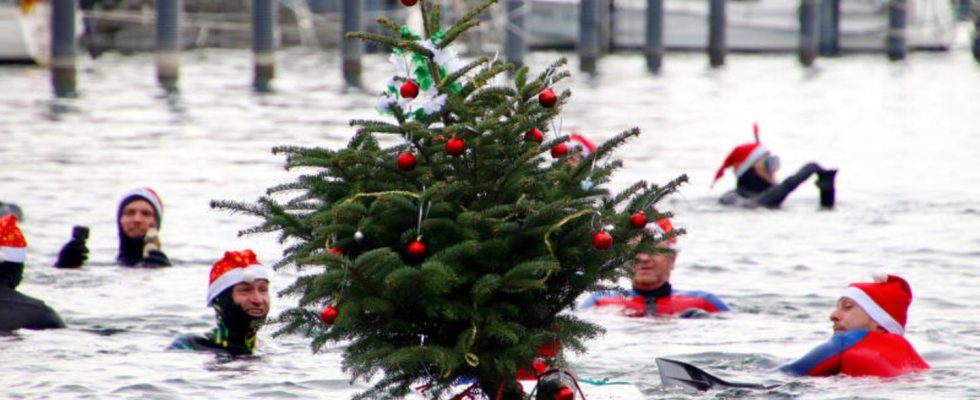questions and answers
What are the chances of a white Christmas this year?
Will Christmas be canceled again this year?
© Davor Knappmeyer / DPA
The tree is glowing inside, the snow is piling up outside: this is how many people imagine an ideal Christmas. But with climate change, the opportunities are dwindling. This year they are not doing well either. An overview.
Claim: There will never be a white Christmas in this country again.
Evaluation: Unlikely – but the chances actually decrease.
Facts: Older people in particular often romanticize the past. It is often said that there used to always be snow at Christmas. Is that really true?
There is no official definition of “white Christmas”, but the DWD speaks of it when at least one centimeter of snow is measured at a weather station in the morning on December 24th, 25th or 26th. Answers to the most important questions.
What are the ingredients for a white Christmas?
According to the DWD, a white Christmas is a rarity in large parts of Germany, at least if you don’t live in the higher low mountain ranges or on the edge of the Alps. “A lot has to come together,” says DWD climate expert Karsten Friedrich about the snow cover on the holidays. There must be enough cold and moisture.
The problem: Cold air that comes from the north or northeast is usually dry and does not bring any precipitation. Milder air from the west often brings moisture but rarely snow. The mix in the weather kitchen has to be right. This was the case at the beginning of December.
What about regional differences?
Whether there is a higher probability of snow at Christmas also depends on where you live in Germany. In general, the higher up you live, the higher the probability that there will be snow on your doorstep at Christmas. However, in some years, such as most recently in 2022, there wasn’t even enough for a white Christmas in the Alpine region, recalls Friedrich.
If you never want to see snow at Christmas, you should go to the sea, advises the weather expert. Because the North and Baltic Seas still retain heat from the summer in December, it is usually milder on the coast.
Winter weather
Good-humoured bears and shocked dachshunds – animals also have divided opinions about snow
Is Grandpa right – was Christmas more often white in the past?
The probability of a white Christmas in Germany’s lowlands has never been particularly high, but it was certainly higher in Grandpa’s youth than it is now. This emerges from an evaluation of the climate archive of the National Weather Service: A comparison of the reference periods 1961–1990 and 1991–2020 shows that the chance of snow cover on all three Christmas days has decreased by more than 50 percent overall.
An example from the south of Germany, which was once spoiled by snow, makes this clear: in the Bavarian capital Munich in 1961–In 1990 there was a white Christmas about every three years, in 1991–In 2020, this only occurred about once every seven years.
When did Germany last have a white Christmas?
The last time there was a widespread white Christmas in this country was in 2010. According to the DWD, 13 years ago the snow cover was still patchy on the morning of December 24th, but “by Christmas Eve, fresh snow ensured a snow cover throughout Germany.” Such more or less comprehensive white Christmases are rare.
In total, this has only happened four times since the 1960s – before 2010 1962, 1969 and 1981.
Is Christmas just at the wrong time?
It’s the same almost every year: Shortly before the festival, the so-called Christmas thaw sets in, which the DWD describes in detail in its lexicon. Mild Atlantic air flows in from the west and sometimes brings rain. Previously fallen snow disappears. According to the DWD, the “infamous Christmas thaw” is one of the so-called singularities – also called weather control cases – and, depending on the region, occurs with a probability of up to 70 percent.
That means: Christmas is at the wrong time. “The probability of snow is greatest in midwinter,” says Friedrich, referring to the month of January.
What happens next in times of climate change?
Climate researcher Valeri Goldberg from the TU Dresden calls the period since 2010 the “now the longest continuous period of years with a green Christmas holiday since weather records began.” This refers to the Saxon state capital in the years 1884 to 2021.
This suggests the influence of global warming. There is a connection between warming of the atmosphere and oceans and the decreasing frequency of white Christmases in Central Europe, writes Goldberg. The likelihood of snowy weather in winter is decreasing – especially in the lowlands. For this to happen, frosty and moist air masses would first have to reach Central Europe from the polar region.
Climate projections show that winters in Central Europe will warm up by three to four degrees on average and up to 5.5 degrees at peak by the end of the 21st century. It can be assumed that a white Christmas will then “become a very rare event,” predicts climate researcher Goldberg.


